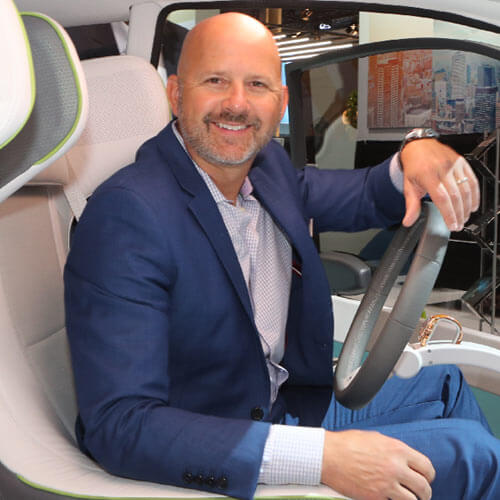Consumer Experiences | Customer Experience Personalization
Experiences Per Mile Advisory Council unveils new study on automotive mobility transformation from 2020 to 2030
As the shift from cars ‘being connected’ to cars being ‘consumer experiences’ continues to grow, the global automotive industry is in the state of disruption due to technological advancements across connectivity, autonomous vehicles and shared mobility. We like to think of this as going from RPM to EPM – or, Experiences per Mile. Further, consumer expectations are increasingly centered around experiences over features – organizations must explore new ways to deliver connected automotive experiences that are hyper-individualized and transcend the simple act of going to enabling a state of being.
Today, the Experiences Per Mile Advisory Council – a collaboration of exclusive automotive and technology stakeholders aimed at solving the complex issues facing the industry both today and tomorrow – published a new report analyzing what the future of mobility transformation will look like in decade ahead. The report titled, “Experiences Per Mile 2030: Ensuring the Next Decade of Mobility Transformation Puts the Consumer First and Foremost,” features findings that address the massive mobility transformation currently underway – and why collaborative consumer-centric innovation is critical in enabling hyper-individualized user experiences.
The shift to a new standard
After more than a century of business as usual, the industry now has aggressively shifted gears towards an ambitious new course: “CASE”- the push for more Connected, Autonomous, Shared and Electric mobility solutions. This once far-off future is becoming a reality for the global automotive industry, and fast.
New research conducted by SBD Automotive included in the EPM 2030 Report predicts that built-in vehicle connectivity will grow sharply from 48% of all new global automobiles to nearly 96% by 2030. Similarly, by 2030, 79% of vehicles shipped around the world will have an L2 autonomy of higher – significantly reducing the risk of crashes through alerts and discrete system actuation. As the consumer values like the sharing economy and sustainability continue to take hold, SBD automotive estimates that 26% of mobility profits will be derived from new sources such as on-demand mobility, while 24% of all new cars sold by 2030 will be electric.
To meet new mobility demands, this requires a complex ecosystem of providers who are evolving their organizational models, business practices and services. Automakers are determining how much to shift their approach into the new normal, while continuing to fuel current investments and satisfy stakeholders. Dealerships are often the first touchpoint for the new consumer mobility experience, but face challenges in terms of execution. Mobility providers and suppliers are under extreme pressure to deliver solutions that underpin each CASE technology, but face safety, regulation and labor restrictions.
Consumer expectations don’t stop at connectivity
As the world becomes more connected, the existence of technology in our day-to-day lives has become table-stakes. Consumer expectations are now shifting from demanding just “smart” technologies – to requiring integrated and meaningful connected experiences. But while the vast majority of consumers report they’re relying on technology more today than they did just a few years ago – nearly 40% feel this abundance of connected solutions is becoming too complicated. Today, the automotive ecosystem is challenged to not just deliver more technology, but deliver smart solutions as holistic, connected experiences that reinforce usability and drive mass adoption.
To bridge this gap between technology and experience, the EPM 2030 Report uncovered three key focus areas that are paramount to driving meaningful innovation:
Reduce Complexity to Remove Barriers
Technology is getting too complicated. This is likely a reflection that while many of these devices work well individually, integrating them all into a seamless digital and mobility experience is getting harder.
Focus on Usability and Familiarity
Cars rank lower-than-average when it comes to usability. The majority of all respondents feel that staying connected and productive in the car is a challenge – with many struggling to read SMS messages, keep up with news or safely check their calendars on the go.
Prioritize Experience in Connectivity
Digital experiences have become a key factor when purchasing a vehicle. Respondents listed the following items as the top digital things (of top 10 things) they will look for in the next car they buy: enables better productivity while driving; provides helpful suggestions on things like gas stations or alternative routes; makes it easier to stay in touch with friends/family when driving; and provides a fun and entertaining environment.
“Consumers are at the heart of the mobility experience, and as technological advancements continue to disrupt the marketplace, no single company can possibly deliver on these experiences. And it won’t happen all at once,” said Jeffrey Hannah, Director, North America of automotive research firm SBD Automotive. “Through open collaboration and true partnerships, the automotive industry can prepare for the next decade of mobility transformation and ultimately, create a more connected world.”
Rethink innovation with consumer-oriented collaboration
To maintain pace with innovation and respond to growing consumer pain-points around connectivity, collaboration across industries, organizations and economies is paramount. Further, it must be centered on the collective consumer experience, and how disparate technologies and services can come together to create cohesive use cases for automotive customers.
“The purpose of the EPM Advisory Council is to uncover best practices and foster cross-industry collaboration, but it really starts with understanding and ensuring we all start with the consumer pain points, and really, the consumer insights,” said Tom Rivers, Vice President, Connected Car & Connected Services Marketing, HARMAN. “Then, we can solve for those consumer pain points during the in-vehicle experience. And that’s the greatest benefit of the council – the consumer will have a better experience while moving from one location to another.”
Based on research findings, the EPM 2030 Report outlines five core consumer benefits where advanced collaboration will fuel better experience in the vehicle for drivers and passengers alike:
- Accomplishment: Enhance personal productivity and support drivers’ ability to safely multitask.
- Well-being: Develop experiences that enhance consumers’ physical safety and digital security, as well as the personalized in-vehicle atmosphere which reduces stress and monitors their physical well-being.
- Social Connection: Build safe, personal connections inside and outside the vehicle – such as location-sharing of routes and time of arrival, shared mobility experiences via social media platforms and more.
- Enjoyment: Ensure a fun and enriching mobility experience, with the ability to consume video and audio entertainment and enable personalized moments of discovery in a safe manner.
- Environmental Consciousness: Deliver new mobility options and eco-focused technologies that can decrease carbon footprint and environmental impact.
By fueling cross-industry collaboration and driving towards the same consumer experience objectives, we can advance the connected automotive industry and introduce meaningful technology and innovation.
For more information, download the EPM 2030 Report or visit www.experiencespermile.org
# # #

Tom Rivers
Harman International

Jeffrey Hannah
SBD Automotive